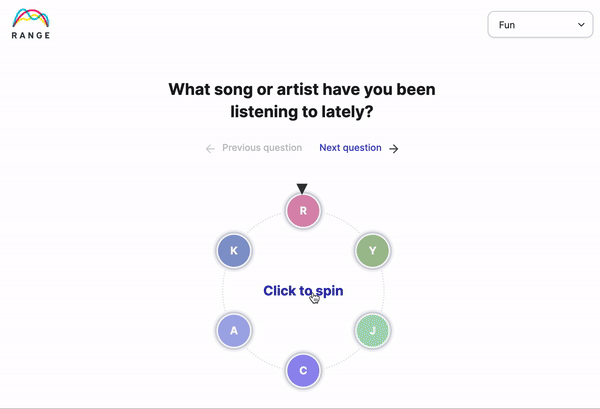
Rituals, according to psychologists, are the habits and customs we perform routinely with little or no thought. And as humans, we crave them.
Rituals bring order and calm to our often unpredictable lives. In groups, they foster a sense of community, belonging, and shared values, and have been used throughout our history to bring folks together during good times and bad. They make us more effective too.
According to Harvard researchers, rituals improve our performance in both public and private settings by reducing anxiety and helping us stay clear-headed.
At work, rituals help leaders and teams build culture, executive more effectively, and improve teamwork.
They’re especially valuable—but often challenging to get right—on hybrid or remote teams, where it’s harder to feel a sense of belonging.
In this article, we’ll break down how to think about rituals on your own team and share examples of remote and hybrid team rituals to get your started.
What are team rituals?
Team rituals are customs your team performs routinely together. Whether you’re aware of it or not, you probably have some team rituals already. Things like a weekly team lunch (virtual or IRL), daily standups, or a new hire onboarding course are all examples of team rituals.
Why team rituals are important
Rituals help teams foster belonging.
In a recent article, Range co-founder Dan Pupius explains why belonging is something every leader should care about.
“Team members need a sense of belonging to feel comfortable. They want to know that their work matters not only to their manager but to their co-workers. Nobody wants to feel like they're not pulling their weight, and when a team is firing on all cylinders, every individual feels like they have a role to play and are vital to the success and happiness of their peers. It's in rituals, both large and small, that team members gain that sense of camaraderie while feeling both supported and valued.” — Dan Pupius, Co-founder of Range, Inc.com
The benefits go both ways too. When folks feel valued by the team and leadership, they’re more likely to feel a deep level of accountability in their work and execute at a higher level.
Why rituals are key for remote and hybrid teams
To be most creative, you need to feel open and connected to your team.
When you're in the same office—it happens pretty naturally. You chat with people in the elevator, go out for lunch or a beer after work. You share stories about your life and your history which help people understand and relate to you better.
For remote or hybrid teams, rituals can help create some of that same understanding even while being apart. It takes more intention to get to know each other in the same way—but the work is critical if you want your team to work effectively together.
When to use team rituals
Team rituals can help foster connectedness and engagement during many different workplace moments. Here are a few examples of times when investing in team rituals can be impactful.
- To build culture and team rapport: Rituals help bring teams together through shared experience, and can be a powerful tool when folks are feeling disconnected or as your team grows.
- To drive momentum around work and projects: Team rituals can help keep teammates more energized and on-track as they work together to tackle a common goal. They might be process-related, like project kick-offs and daily check-ins, or more celebratory like a weekly moment of gratitude.
- To onboard new teammates: When new hires participate in rituals, it quickly helps them feel a greater sense of purpose and belonging within the org. For instance, Google new hires wear colorful beanies that say “Noogler” to initiate them into the group—it’s a shared experience that connects all employees.
- To support the team—especially during major shifts: Investing in rituals as your team grows or experiences big shifts, like a reorg, can help bring folks together and build a more supportive culture.
How to establish the right rituals for your team
Landing on the right team rituals is an iterative process. Like most new things your team tries, the best way to know what’s working is to observe and check-in with your team regularly. Here are some questions you can ask yourself and your team as you go.
- What are we looking to accomplish?
- What gives each of us energy? Are we a group of introverts? Extroverts? Or (most likely) a mix?
- Is this activity something people look forward to?
- After we take part in the ritual, what’s the impact on folk’s energy and engagement?
- How did individuals feel about themselves after participating?
- How did individuals feel about the team or project after participating?
8 ideas for remote and hybrid team rituals
Virtual water cooler or coffee chats
In an office, you’ve got snack kitchens, coffee corners, and break rooms as a space to casually connect with your teammates. When you’re remote or hybrid, it’s important to invest in virtual forums to do the same. You’ll see huge benefits to team trust and connectedness.
Whether it’s a designated Slack channel or 30-minute Zoom each morning, be sure you’re offering space where teammates can opt-in or out, without worrying that they're distracting others who are focusing on a task.
�“We have a #coffeecooler Slack channel, a hat tip to a verbal slip-up one of our founders made during a conference panel a few years back. Finding common ground with co-workers through similar interests and humor immediately makes a team feel more like a family, whether in-person or remote.” — Dan Pupius, CEO of Range
2. Team all-hands or recap meeting
Coming together to recap milestones and celebrate each other’s work is a powerful way to reinforce purpose within the team. Depending on your team’s size and structure, you might choose to hold a team all-hands meeting week, bi-weekly, or monthly.
At Range, we hold a bi-weekly cycle recap meeting where we lift up successes, share “noble failures”, and celebrate major milestones together as a team.
3. Daily team icebreaker
Looking for a lightweight daily ritual to build team culture and trust? Trying kicking off each morning with a daily team question or icebreaker—it’s fast, fun, and helps folks get to know each other better, which ultimately improves team dynamics.
Our free icebreaker tool has lots of different questions (serious, fun, and everything in between) to get you started.

Try our (free) icebreaker spinner today
Kick off your next meeting with one of 300+ icebreaker questions to help everyone feel more connected and engaged.
4. #Team-gratitude Slack channel
When folks feel recognized for their work on contributions on a regular basis, they’re more likely to feel a strong sense of purpose and belonging within the team.
Practicing gratitude for your teammates can increase job satisfaction (), and fuel greater teamwork too.
Something as simple as a Slack channel where you tag your teammates to say thanks can be a powerful ritual that shows everyone just how meaningful their contributions are.
“Setting aside time to express gratitude is great because you can let your teammates know that they had a positive impact on you and your work, and by the same token, you learn how you made someone's day a bit better when you might not have realized it. Giving gratitude is as valuable to the giver as the receiver; gratitude has clear health benefits, helps people cope with stress, and means you will build stronger relationships.” — Dan Pupius, CEO of Range
5. Social game time
Many remote and hybrid teams choose group game time as a ritual. Why? Well, not only are games ridiculously fun—they’re also proven to drive motivation, productivity, and performance.
One study even found that new teams perform 20% better on tasks following a 45 minute collaborative game.
At Range, we have a 30 minute game time scheduled every Tuesday. Everyone is invited and typically between a third and a half of the team show up each time. It’s a great opportunity to connect with teammates, have a little fun, and take a break from remote work monotony.
Online drawing games are our favorite… and we’re always looking for new challengers. ;)
6. Async daily check-ins
Many teams choose to create a daily ritual around checking in with one another—it’s a great way to keep a pulse on how everyone’s doing and keep the whole team in-sync.
When you’re all in the office, check-ins might take the form of a daily standup.
When you’re hybrid or remote, checking in usually happens asynchronously
Async daily updates can be done directly in Range in less than 5 minutes. They let everyone know what you're working on and what you may need help with, and even include team-building questions to help everyone stay connected.
7. Creative power hour
Soundcloud compositions.
Graphic novels.
Short-story chapbooks.
Crocheted stuffed animals.
No matter what your teammates create outside of work, setting aside group time to chip away at passion projects is a surefire way to ignite inspiration and bring folks closer together.
At Range, we’ve experimented with an (optional) biweekly meeting called “The Creative Range.”
Anyone on the team can drop in, share a bit about a hobby or interest of theirs, and spend all or part of the hour making progress on a non-work project.
8. Show & tell
Get-to-know-you rituals like “show & tell” can help teammates learn about each other as people, find common ground, and build understanding.
At Range, our version of show & tell is a biannual team zine (short for magazine). Everyone collaborates and contributes in their own way. People draw comics, make infographics, and share stories. We cover a different topic each time, like “How I spent COVID” or “Stories from our youth.”
“Show & tell” doesn't have to look like a zine, it could be a few slides at a team meeting or a “how to” lesson based on a talent or interest — how to ski from a helicopter, make your own wine, or sew a quilt.
Get your rituals going with Range
Range makes it easy to connect with your teammates and build belonging through rituals that stick.
With Range Check-ins, you can share what you’re working on, see how everyone’s doing, bond over a team question, and share your gratitude to teammates.
Build your rituals with:
- Lightweight daily progress updates to fuel trust and accountability
- Culture-building icebreaker questions to get to know each other
- Mood-sharing prompts (using emojis and colors) to encourage vulnerability
- Gratitude prompts to show you value each other’s work
- Daily reminders to make it easy to build the ritual
- Plus, check-in via Slack where the conversation is already happening
Range helps remote and hybrid teams build meaningful rituals and deep connections. All in about 5 minutes each morning.








